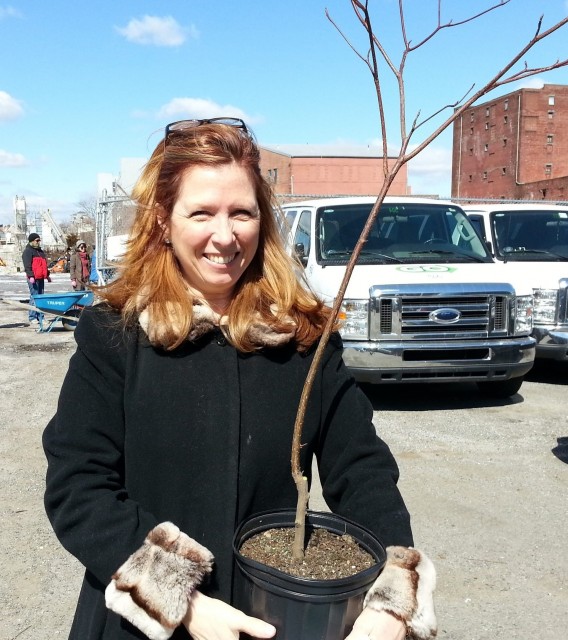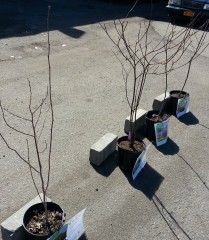 Trees are going up faster than storms are taking them down in New York City.
Trees are going up faster than storms are taking them down in New York City.
Dozens of people lined up in a parking lot between some industrial buildings and the Gowanus Canal in Brooklyn on a recent sunny Saturday morning to pick up stick-figure-sized Redbud trees about four feet tall. More than half of the 100 trees ready to go were picked up within the first 45 minutes of a two-hour stretch, said Sophie Plitt, Forestry Coordinator of New York Restoration Project.
About once a week in the spring and fall, the NYRP – in conjunction with the city – goes to different neighborhoods and gives away trees for free. (See our coverage of this year’s free tree announcement for upcoming giveaway dates and locations.)
 The last three tree giveaways of 2012 were canceled after Hurricane Sandy. The storm knocked down more than 10,000 trees, said Tara Kiernan, a spokeswoman for the Parks Department. That’s fifteen times as many tree casualties than after 2011’s Hurricane Irene, which took down about 650 trees.
The last three tree giveaways of 2012 were canceled after Hurricane Sandy. The storm knocked down more than 10,000 trees, said Tara Kiernan, a spokeswoman for the Parks Department. That’s fifteen times as many tree casualties than after 2011’s Hurricane Irene, which took down about 650 trees.
But since 2007, about 662,000 trees have taken root, or an average of more than 100,000 a year. This growth is a result of the “MillionTreesNYC” program, a PlaNYC partnership between the city and NYRP.
“All in all, I would not say [Sandy] is a significant set-back for MillionTreesNYC,” said Mike Mitchell, NYRP community initiatives manager.
“Tree loss was factored in at the beginning,” he noted, “whether it be from storms, mechanical damage, soils salted from people clearing snow from their sidewalk, people pouring concrete or laying bricks around the base of a tree, etc.”
The new replace the casualties. Older trees are more vulnerable to storms because they have more leafs, said Mitchell. “Because young trees have less canopy,” he added, “their branches are more supple, and they have significantly less leaf surface area to be blown like a sail.”
However, according to Kiernan, the little guys have more than just youth going for them. “Thanks to new planting methods we’ve implemented and careful consideration given to species selection and planting locations,” she said, “our newly planted trees have been less susceptible to storm damage.”
In 2011, the New York Times citied studies that said 7 to 11 percent of newly planted trees die within two years. However, almost all the trees felled by storms were later reported by the New York Observer to be old trees that predate the MillionTreesNYC program.
Prior to MillionTreesNYC, the city planted 10,000 trees every year–about the same number knocked by Sandy.
The city’s winning battle to add to the estimated five million trees across the boroughs can be attributed to the thousands of New Yorkers who line up to pick up the bark and do the planting independently at home. Only New York City residents are allowed to take the trees and the rules limit each household to a tree, Plitt said.
The boroughs with the highest turnouts at tree giveaways are Queens, Brooklyn and Staten Island, said Mitchell. “A lot of the time this has to do with the fact there are fewer households with green space in the areas we do tree giveaways in the Bronx and Manhattan,” he noted.
The focus of MillionTreesNYC, which started with a tree planted on Teller Avenue in the Bronx, has been in neighborhoods with a scarcity of trees. The Parks Department focuses on planting trees in public spaces such as sidewalks and parks.
From the NYRP site in Gowanus, Forestry Coordinator Sophie Plitt speaks about Eastern Redbuds and the experience of giving trees:
[youtube http://www.youtube.com/watch?v=vls4TsS5pLk]
Photos and video: Shannon Ayala